Method for the Quantitative Evaluation of Low-Permeability Reservoir Damage in the East China Sea Based on Experimental Evaluation and Modeling Calculation
Abstract
1. Introduction
2. Materials and Methods
2.1. Experimental Materials and Instrument
2.2. Dynamic Damage Mechanism of Drilling Fluid
2.3. Experiment for Evaluation of Dynamic Damage Caused by Drilling Fluid
- (1)
- Experimental steps of formation water damage displacement:
- ①
- Pre-treatment of rock sample and evacuation of saturated formation water for 48 h;
- ②
- Measurement of the positive permeability K0 of rock sample with formation water;
- ③
- On the DTSH-III multi-functional damage evaluation instrument, the rock sample is contaminated with drilling fluid for 60 min under the pressure difference of 3.0 MPa, and the liquid output is measured;
- ④
- The formation water forward drive is used to calculate the permeability of the rock sample Kd and the permeability flowback recovery rate of the rock sample Kd/K0.
- (2)
- Gas damage displacement test steps:
- ①
- Rock samples are pretreated, saturated formation water is evacuated for 48 h, and irreducible water saturation is established by nitrogen gas flooding for 1 h under 2 MPa pressure difference;
- ②
- Measurement of the positive permeability K0 of rock sample with nitrogen;
- ③
- On the DTSH-Ⅲ multi-functional damage evaluation instrument, the rock sample is contaminated with drilling fluid for 60 min under the pressure difference of 3.0 MPa, and the liquid output is measured;
- ④
- The permeability Kd of the rock sample and the recovery rate Kd/K0 of the permeability flowback of the rock sample are calculated by nitrogen forward drive.
3. Results
3.1. Dynamic Damage Evaluation of Reservoir under Formation Water Conditions
3.2. Reservoir Dynamic Damage Evaluation under Gas Drive Conditions
4. Physical Model of Drilling Fluid Damage
5. Discussion
5.1. Mathematical Model and Calculation Results of Formation Drilling Fluid Pollution Depth
5.1.1. Mathematical Model of Filtrate Invasion Depth under Formation Conditions
5.1.2. Calculation Results of invasion Depth under Formation Conditions
5.2. Calculation Method of Formation Drilling Fluid Pollution Skin Factor
5.2.1. Calculation of Drilling Fluid Invasion into Skin in Well XH-1
5.2.2. Calculation of Drilling Fluid Invasion Skin in Reservoir
6. Conclusions
Author Contributions
Funding
Data Availability Statement
Conflicts of Interest
References
- Apaleke, A.S.; Al-Majed, A.; Hossain, M.E. Drilling fluid: State of the art and future trend. In Proceedings of the SPE North Africa Technical Conference and Exhibition, Cairo, Egypt, 20–22 February 2012. SPE-149555-MS. [Google Scholar]
- Saychenko, L.; Tananykhin, D.; Ashena, R. Prevention of scale in the downhole equipment and productive reservoir during the oil well operation. J. Appl. Eng. Sci. 2021, 19, 363–368. [Google Scholar] [CrossRef]
- Yang, X.Y. Drilling fluid and completion fluid technology for reservoir protection: Present and future. Drill. Fluid Complet. Fluid 2000, 17, 6. [Google Scholar] [CrossRef]
- Yang, J.; Sun, J.; Bai, Y.; Lv, K.; Zhang, G.; Li, Y. Status and prospect of drilling fluid loss and lost circulation control technology in fractured formation. Gels 2022, 8, 260. [Google Scholar] [CrossRef] [PubMed]
- Zhonghua, W. Current Situation and Development Suggestions for Drilling Fluid Technologies in China. Pet. Drill. Tech. 2023, 51, 114–123. [Google Scholar]
- Yan, Z.; Jianhua, B.; Jinhong, Z.; Hongying, S.; Ling, T. Research progress and development trend of drilling and completion fluids for oil and gas reservoir protection. China Chem. Trade 2015, 146, 050801. [Google Scholar] [CrossRef]
- Guo, C. Current Status and Prospects of Waste Oil-Based Drilling Fluid Treatment Methods in China. In Proceedings of the International Petroleum and Petrochemical Technology Conference 2020, Shanghai, China, 26–28 August 2020; Springer: Singapore, 2021; pp. 94–104. [Google Scholar]
- Dindoruk, B.; Zhang, F. Advances in Drilling and Completion Fluid Technologies for Protecting Oil and Gas Reservoirs: Research Progress and Development Trends. J. Energy Resour. Technol. 2024, 146, 050801-1. [Google Scholar] [CrossRef]
- Zhang, Y.; Chen, Y.; Wang, C.; Yan, C. Study on Reservoir Damage Mechanism and Drilling and Completion Fluid Protection Technology in BOHAI A Oilfield. Guangdong Chem. Ind. 2022, 49, 79–82. [Google Scholar]
- Han, L.; Clinch, D.; van der Zwaag, C.; Galletti, E.; Fornasier, F.; Estevez, F.; McMillan, N.; Green, J.; Ian, P. Customizing Drill-In Fluid for Peregrino Project in Brazil: Laboratory Development and Field Experience. In Proceedings of the SPE International Symposium and Exhibition on Formation Damage Control, Lafayette, LA, USA, 15–17 February 2012. [Google Scholar] [CrossRef]
- Doane, R.D.; Bennion, D.B.; Thomas, F.B.; Bietz, R.R.; Bennion, D.W. Special Core Analysis Designed to Minimize Formation Damage Associated with vertical/Horizontal Drilling Applications. Can. Pet. Technol. 1999, 38, 35–45. [Google Scholar] [CrossRef]
- Jin, L. Quantitative Formation Damage Evaluation Using Dynamic/Static Drill-In Fluid Filtration Tests Data. In Proceedings of the SPE/IADC Drilling Conference and Exhibition, Amsterdam, The Netherlands, 17–19 March 2009. SPE-118659-MS. [Google Scholar]
- Iscan, A.G.; Civan, F.; Kok, M.V. Alteration of permeability by drilling fluid invasion and flow reversal. J. Pet. Sci. Eng. 2007, 58, 227–244. [Google Scholar] [CrossRef]
- Ibrahim, D.S.; Sami, N.A.; Balasubramanian, N. Effect of barite and gas oil drilling fluid additives on the reservoir rock characteristics. J. Pet. Explor. Prod. Technol. 2017, 7, 281–292. [Google Scholar] [CrossRef]
- Kalhor Mohammadi, M.; Riahi, S.; Boek, E.S. An insight review on formation damage induced by drilling fluids. Rev. Chem. Eng. 2023, 39, 387–415. [Google Scholar] [CrossRef]
- Al-Yaseri, A.Z.; Lebedev, M.; Vogt, S.J.; Johns, M.L.; Barifcani, A.; Iglauer, S. Pore-scale analysis of formation damage in Bentheimer sandstone with in-situ NMR and micro-computed tomography experiments. J. Petrol. Sci. Eng. 2015, 129, 48–57. [Google Scholar] [CrossRef]
- Alcheikh, I.M.; Ghosh, B. A comprehensive review on the advancement of non-damaging drilling fluids. Int. J. Petrochem. Res. 2017, 1, 61–72. [Google Scholar] [CrossRef]
- Muniz, E.S.; Da Fontoura SA, B.; Duarte, R.G.; Lomba, R.T. Evaluation of the shale-drilling fluid interaction for studies of wellbore stability. In Proceedings of the ARMA US Rock Mechanics/Geomechanics Symposium, Anchorage, AK, USA, 25–29 June 2005. ARMA-05-816. [Google Scholar]
- Ladva, H.K.J.; Brady, M.E.; Sehgal, P.; Kelkar, S.; Cerasi, P.; Daccord, G.; Foxenberg, W.E.; Price-Smith, C.; Howard, P.; Parlar, M. Use of oil-based reservoir drilling fluids in open-hole horizontal gravel-packed completions: Damage mechanisms and how to avoid them. In Proceedings of the SPE European Formation Damage Conference and Exhibition, The Hague, The Netherlands, 21–22 May 2001. SPE-68959-MS. [Google Scholar]
- Bennion, D.B.; Lunan, B.; Saponja, J. Underbalanced drilling and completion operations to minimize formation damage-reservoir screening criteria for optimum application. J. Can. Pet. Technol. 1998, 37, 3. [Google Scholar] [CrossRef]
- Tan, W.; Bai, R.; Zou, J.; Wang, S.; Li, X.; You, L.; Kang, Y.; Zhang, L. Drilling fluid damage analysis of fractured metamorphic rock reservoirs in Archaean buried hills in a block of Bozhong. Fault-BlockOilGas Field 2023, 30, 715–720. [Google Scholar]
- Chen, P.; Wang, X.; Dong, Y.; Chen, H.; Chen, A. Prediction model of filter cake buildup and its influential factor. Fault-Block Oil Gas Field 2012, 19, 522–525. [Google Scholar]
- Duan, Y.; Yang, H. Review of mud cake formation mechanism and evaluation method of drilling fluid. Sci. Technol. Eng. 2021, 21, 11443–11454. [Google Scholar]
- Elmgerbi, A.; Thonhauser, G.; Fine, A. Experimental approach for assessing filter-cake removability derived from reservoir drill-in fluids. J. Pet. Explor. Prod. Technol. 2021, 11, 4029. [Google Scholar] [CrossRef]
- Pan, H.; Fan, Z.; Ma, Y. Correction method of drilling fluid invasion of resistivity logging. Nat. Gas Ind. 2005, 25, 41–43. [Google Scholar]
- Min, W.A.; Wancai, L.I.; Xue, F.E. On Drilling Fluid Invasion Influence on Resistivity Logging Characteristics by Numerical Modeling and Experimental Method. Well Logging Technol. 2015, 39, 272–276. [Google Scholar]
- Luo, Y.; Zhang, J.; Wang, S. Usi ng Logging Data to Evaluate Invasion Damage in drilling Process. Well Logging Technol. 2006, 6, 568–570+586. [Google Scholar]
- Zhang, H.; Cai, B.; Liu, Y.; Shi, X. Experimental Study on penetration depth of drilling fluid into tight sandstone in an area of east china sea. J. Southwest Pet. Univ. 2017, 39, 152–158. [Google Scholar]
- Guo, D. The Physical Experiment and Numerical Simulation of the Invasion Depth of Drilling Fluid in Sandstone Reservoir; Southwest Petroleum University: Chengdu, China, 2018. [Google Scholar]
- Wu, J. Simulation of Drilling Mud Invasion and Evaluation of Permeability Damage in Sandstone Reservoir; China University of Petroleum: Beijing, China, 2019. [Google Scholar]
- Chen, X. Research on Calculation Model of Filtrate Invasion Radius for Water-Based Drilling Fluid; Northeast Petroleum University: Daqing, China, 2013. [Google Scholar]
- Chunping, G. Research on Skin Factor of Drilling Fluid Invasion in Horizontal Wells; Northeast Petroleum University: Daqing, China, 2021. [Google Scholar]
- Fan, S.; Dou, H. The development trend of reservoir protection technology. Pet. Explor. Dev. 2001, 28, 556. [Google Scholar]
- Krueger Roland, F. An overview of formation damage and well productivity in oilfield operations. J. Pet. Technol. 1986, 38, 131–152. [Google Scholar] [CrossRef]
- Schembre, J.M.; Kovscek, A.R. Mechanism of formation damage at elevated temperature. J. Energy Resour. Technol. 2005, 127, 171–180. [Google Scholar] [CrossRef]
- Wojtanowicz, A.K.; Krilov, Z.; Langlinais, J.P. Study on the effect of pore blocking mechanisms on formation damage. In Proceedings of the SPE Oklahoma City Oil and Gas Symposium/Production and Operations Symposium, Oklahoma City, OK, USA, 8–10 March 1987. SPE-16233-MS. [Google Scholar]
- Liao, Z.C.; Xiong, H.L. Oil and Gas Reservoir Protection Technology; Petroleum Industry Press: Beijing, China, 2012. [Google Scholar]



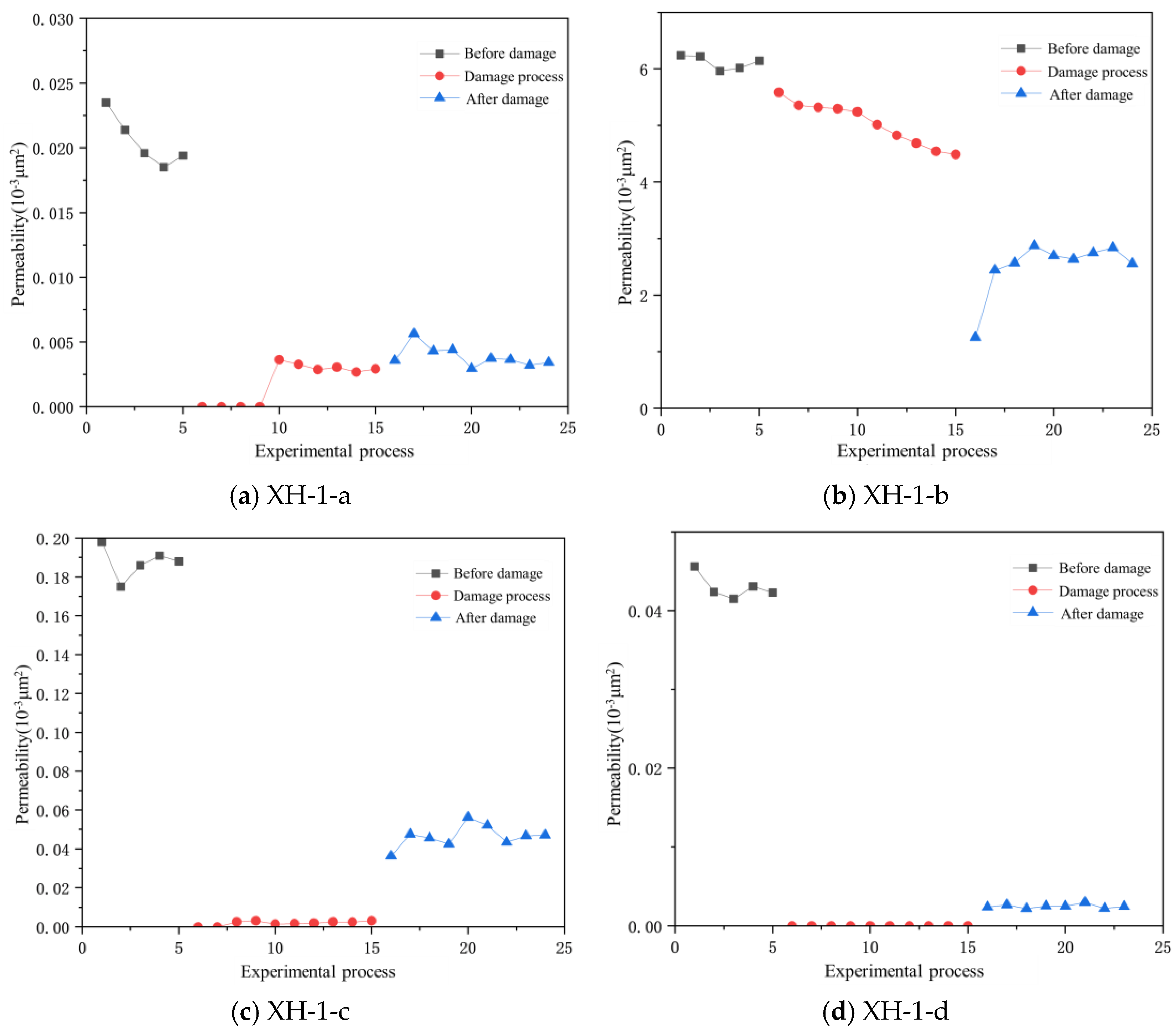
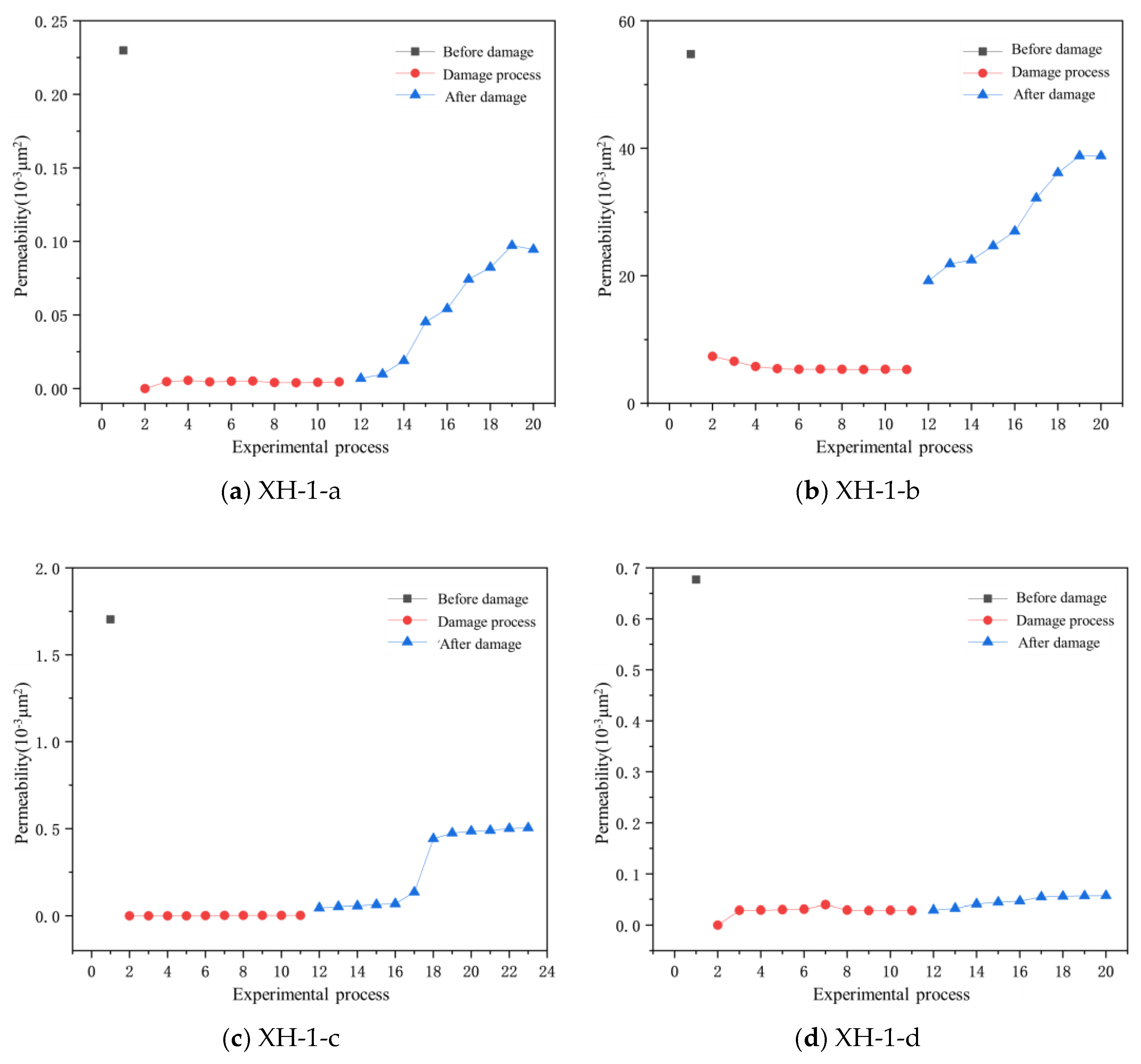




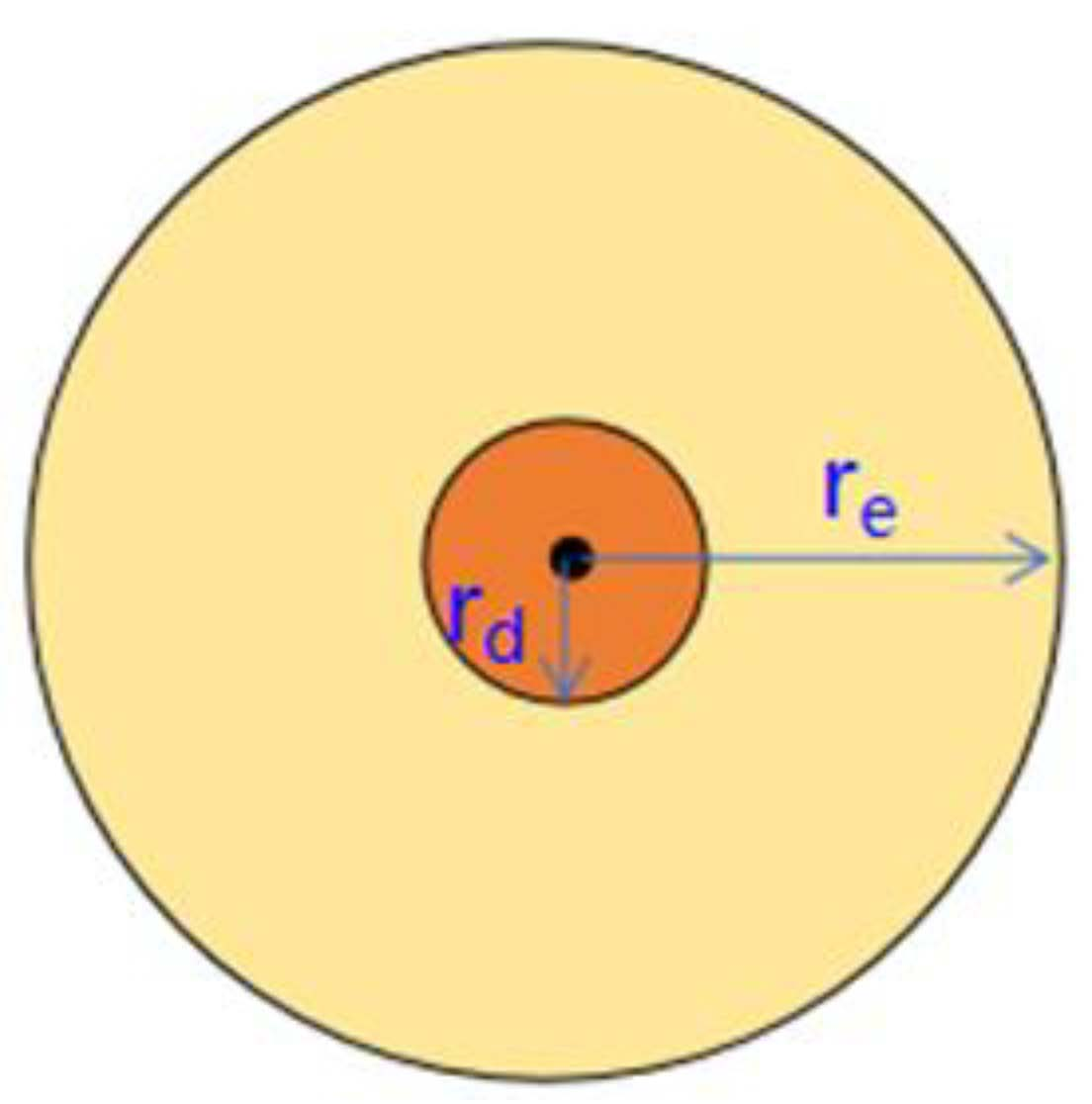


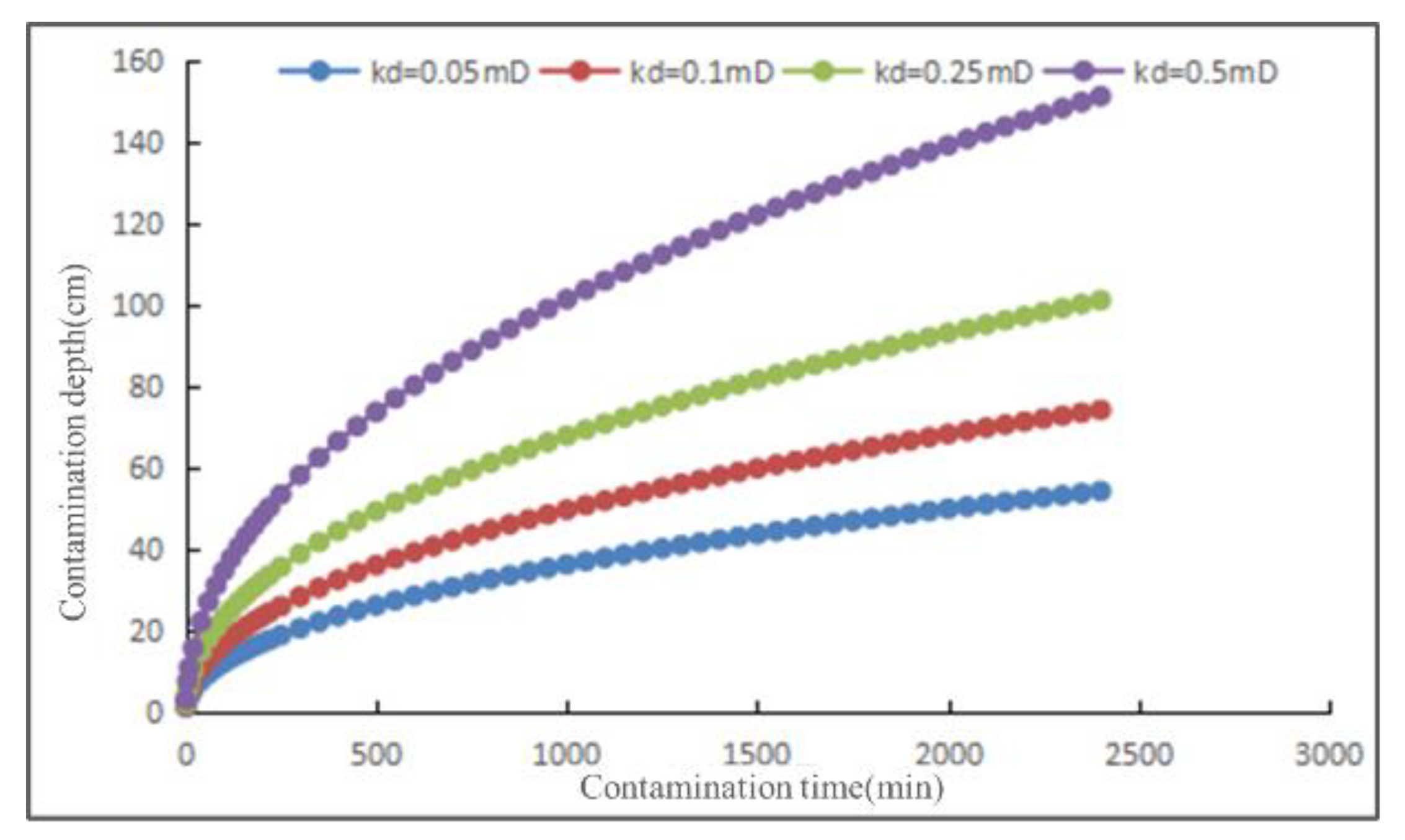
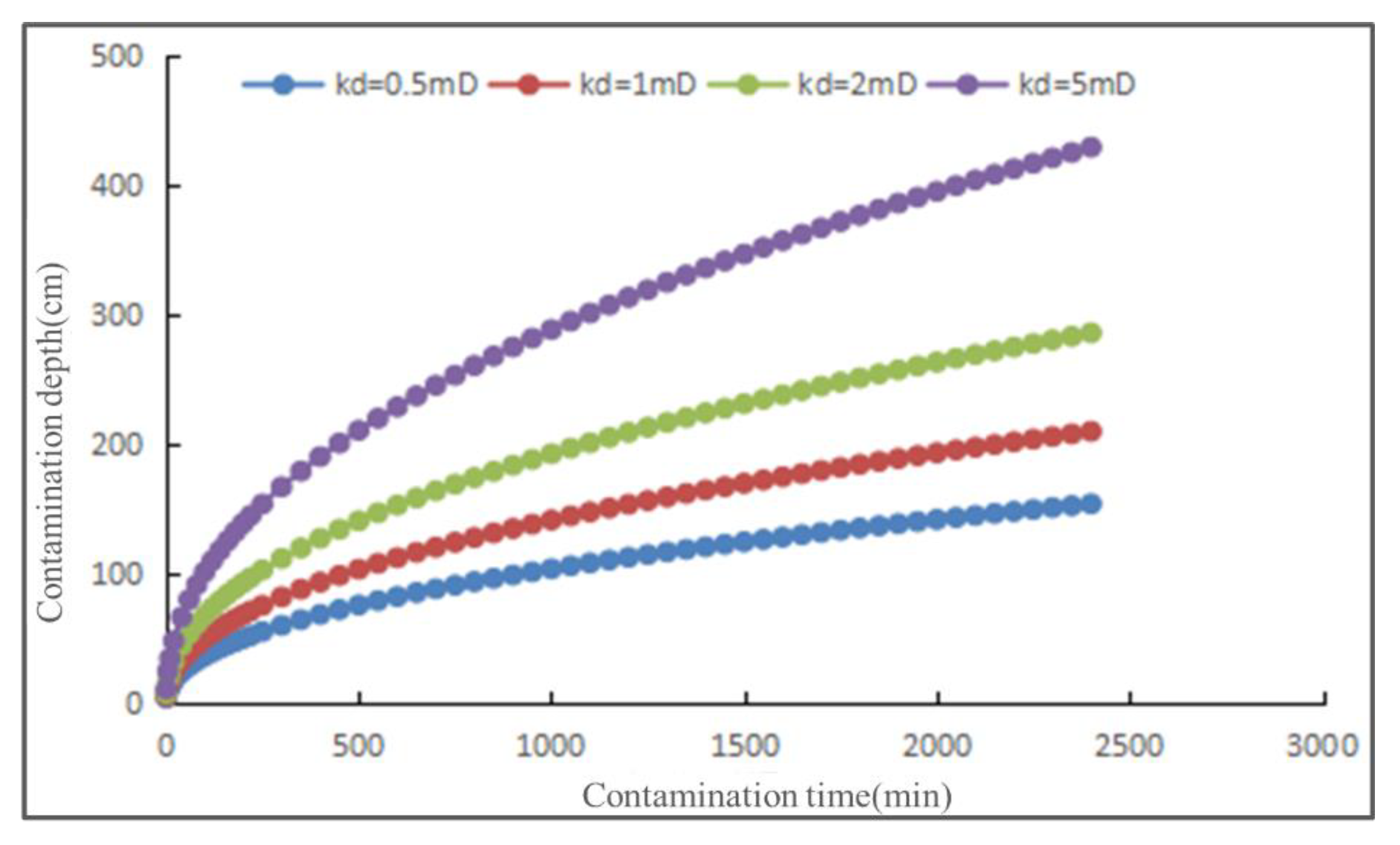
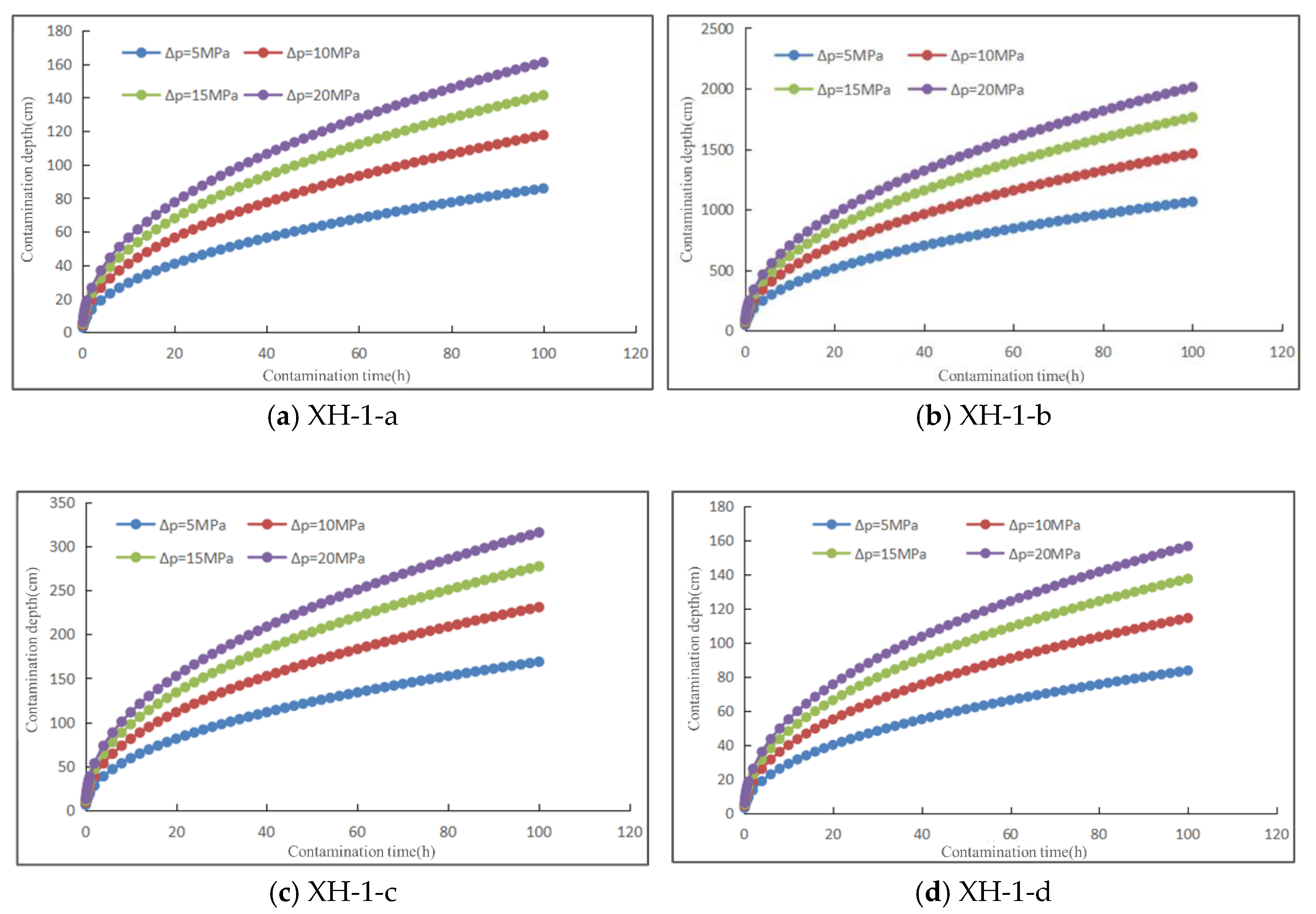
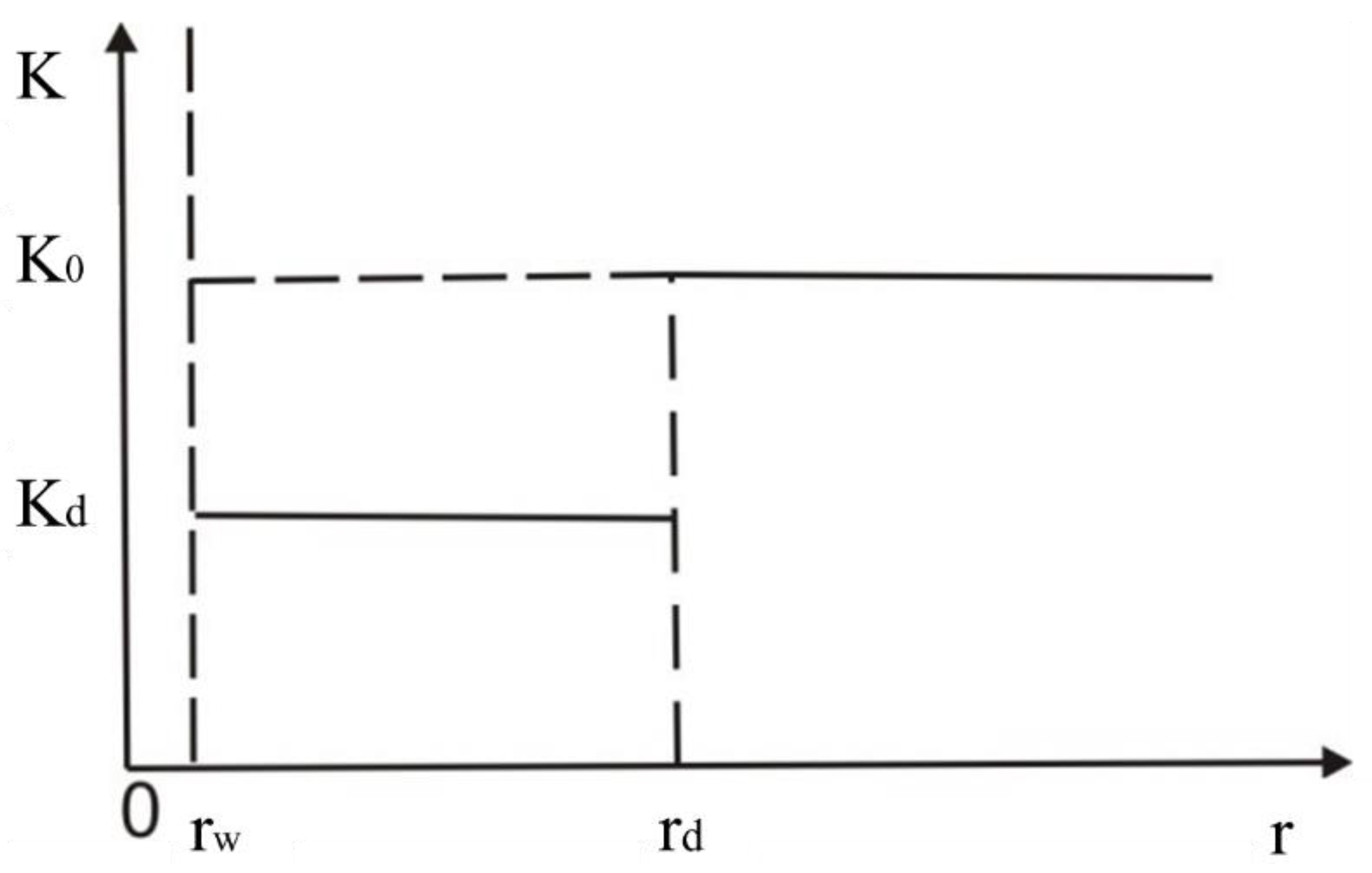

| Core Number | Sampling Depth (m) | Diameter (mm) | Length (mm) | Porosity (%) |
|---|---|---|---|---|
| XH-1-a | 3128.28 | 24.65 | 29.95 | 9.6 |
| XH-1-b | 3418.03 | 24.78 | 63.80 | 12.9 |
| XH-1-c | 3978.68 | 25.14 | 62.72 | 9.3 |
| XH-1-d | 4652.50 | 25.45 | 53.95 | 6.2 |
| Damage Rate Rs (%) | Damage Level |
|---|---|
| ≤5 | / |
| 5~30 | low |
| 30~50 | Medium to low |
| 50~70 | Medium to high |
| >70 | high |
| Core | Permeability before Damage (×10−3 μm2) | Permeability after Damage (×10−3 μm2) | Damage Rate (%) | Damage Level |
|---|---|---|---|---|
| XH-1-a | 0.0192 | 0.0037 | 80.49 | High |
| XH-1-b | 6.0402 | 2.6976 | 55.34 | Medium to high |
| XH-1-c | 0.1876 | 0.0464 | 75.2 | High |
| XH-1-d | 0.0430 | 0.0025 | 94.22 | High |
| Core | Permeability before Damage (×10−3 μm2) | Permeability after Damage (×10−3 μm2) | Damage Rate (%) | Damage Level |
|---|---|---|---|---|
| XH-1-a | 0.2298 | 0.0959 | 58.25% | Medium to high |
| XH-1-b | 54.7865 | 36.5018 | 33.37% | Medium to low |
| XH-1-c | 1.7033 | 0.4911 | 71.17% | High |
| XH-1-d | 0.6771 | 0.0563 | 91.69% | High |
| Core Number | Exposure Time t | ||||||||
|---|---|---|---|---|---|---|---|---|---|
| m | % | % | min | ml/min.m2 | / | m | / | ||
| XH-1-a | 0.0762 | 9.6 | 32.8 | 9360 | 91 | 0.00036 | 0.78 | 3.24 | |
| XH-1-b | 0.0762 | 12.9 | 34.6 | 6048 | 152 | 0.83 | 1.22 | ||
| XH-1-c | 0.0762 | 9.3 | 31.2 | 6912 | 83 | 0.71 | 5.61 | ||
| XH-1-d | 0.0762 | 6.2 | 21.6 | 7488 | 35 | 0.47 | 13.41 | ||
| Contamination Time (h) | Mud Cake Thickness (cm) | |||
|---|---|---|---|---|
| 0.1 | 0.2 | 0.3 | 0.4 | |
| 100 | 60.25 | 43.17 | 34.69 | 29.45 |
| 150 | 74.99 | 54.41 | 44.09 | 37.67 |
| 200 | 87.35 | 63.89 | 52.04 | 44.64 |
| 250 | 98.21 | 72.23 | 59.05 | 50.80 |
| Contamination Time (h) | Mud Cake Thickness (cm) | |||
|---|---|---|---|---|
| 0.1 | 0.2 | 0.3 | 0.4 | |
| 100 | 4.80 | 4.11 | 3.69 | 3.38 |
| 150 | 5.27 | 4.59 | 4.16 | 3.84 |
| 200 | 5.60 | 4.92 | 4.49 | 4.18 |
| 250 | 5.86 | 5.19 | 4.76 | 4.44 |
| Contamination Time (h) | Mud Cake Thickness (cm) | |||
|---|---|---|---|---|
| 0.1 | 0.2 | 0.3 | 0.4 | |
| 100 | 7.16 | 6.14 | 5.50 | 5.04 |
| 150 | 7.86 | 6.84 | 6.20 | 5.74 |
| 200 | 8.36 | 7.35 | 6.70 | 6.24 |
| 250 | 8.75 | 7.74 | 7.10 | 6.63 |
| Contamination Time (h) | Mud Cake Thickness (cm) | |||
|---|---|---|---|---|
| 0.1 | 0.2 | 0.3 | 0.4 | |
| 100 | 10.94 | 9.38 | 8.40 | 7.70 |
| 150 | 12.01 | 10.45 | 9.47 | 8.76 |
| 200 | 12.77 | 11.22 | 10.24 | 9.53 |
| 250 | 13.36 | 11.82 | 10.84 | 10.13 |
| Contamination Time (h) | Mud Cake Thickness (cm) | |||
|---|---|---|---|---|
| 0.1 | 0.2 | 0.3 | 0.4 | |
| 100 | 17.69 | 15.16 | 13.58 | 12.45 |
| 150 | 19.42 | 16.90 | 15.32 | 14.17 |
| 200 | 20.65 | 18.15 | 16.56 | 15.41 |
| 250 | 21.61 | 19.12 | 17.53 | 16.38 |
| Contamination Time (h) | Mud Cake Thickness (cm) | |||
|---|---|---|---|---|
| 0.1 | 0.2 | 0.3 | 0.4 | |
| 100 | 31.32 | 26.84 | 24.05 | 22.05 |
| 150 | 34.38 | 29.93 | 27.12 | 25.09 |
| 200 | 36.56 | 32.13 | 29.32 | 27.28 |
| 250 | 38.26 | 33.85 | 31.04 | 29.00 |
Disclaimer/Publisher’s Note: The statements, opinions and data contained in all publications are solely those of the individual author(s) and contributor(s) and not of MDPI and/or the editor(s). MDPI and/or the editor(s) disclaim responsibility for any injury to people or property resulting from any ideas, methods, instructions or products referred to in the content. |
© 2024 by the authors. Licensee MDPI, Basel, Switzerland. This article is an open access article distributed under the terms and conditions of the Creative Commons Attribution (CC BY) license (https://creativecommons.org/licenses/by/4.0/).
Share and Cite
Zhao, X.; Jiang, Y.; Xu, P.; Yu, J.; Xie, L. Method for the Quantitative Evaluation of Low-Permeability Reservoir Damage in the East China Sea Based on Experimental Evaluation and Modeling Calculation. Processes 2024, 12, 1406. https://doi.org/10.3390/pr12071406
Zhao X, Jiang Y, Xu P, Yu J, Xie L. Method for the Quantitative Evaluation of Low-Permeability Reservoir Damage in the East China Sea Based on Experimental Evaluation and Modeling Calculation. Processes. 2024; 12(7):1406. https://doi.org/10.3390/pr12071406
Chicago/Turabian StyleZhao, Xingbin, Yiming Jiang, Peng Xu, Jun Yu, and Lingzhi Xie. 2024. "Method for the Quantitative Evaluation of Low-Permeability Reservoir Damage in the East China Sea Based on Experimental Evaluation and Modeling Calculation" Processes 12, no. 7: 1406. https://doi.org/10.3390/pr12071406
APA StyleZhao, X., Jiang, Y., Xu, P., Yu, J., & Xie, L. (2024). Method for the Quantitative Evaluation of Low-Permeability Reservoir Damage in the East China Sea Based on Experimental Evaluation and Modeling Calculation. Processes, 12(7), 1406. https://doi.org/10.3390/pr12071406






